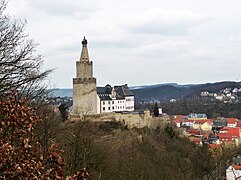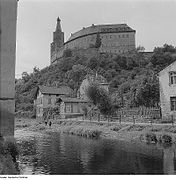Osterburg (Weida)
| Osterburg | ||
|---|---|---|
|
The Osterburg in Weida |
||
| Alternative name (s): | The permanent house in Weida | |
| Creation time : | 1163 to 1193 | |
| Castle type : | Hilltop castle | |
| Conservation status: | Received or received substantial parts | |
| Place: | Weida | |
| Geographical location | 50 ° 46 '21 " N , 12 ° 3' 24.5" E | |
|
|
||
The Osterburg is located on a mountain in the center of the city of Weida in the Thuringian district of Greiz .
history
The latest excavations on the Osterburg provided evidence of the presence of Slavs on the Weidaer Burgberg. A predecessor Slavic castle is suspected on the site of the Osterburg; up to now, however, no Slavic castle complex has been found. The hilltop castle was built by Heinrich I, a brother of the founder of Weida, Vogt Erkenbert II, between 1163 and 1193 as a Romanesque fortification in a strategically favorable mountain location and was ancestral seat of the bailiffs of Weida until the beginning of the 15th century . At first it was called The Weida House. From the bailiffs of Weida, the bailiffs von Gera and the bailiffs von Plauen , lords of the Vogtland named after them , and finally the Princely House of Reuss split off.
At the beginning of the 15th century, the castle passed into the possession of the Margraves of Meißen from the House of Wettin through inheritance distribution and exchange . The castle has been called Osterburg since the 17th century ; the name is derived from the Latin New East Country. Areas of East Thuringia are still called Osterland or Ostland today. The Wettins rebuilt and rebuilt the castle again and again as a result of the Schmalkaldic and Thirty Years War . As the last Wettin resident, Duke Moritz Wilhelm of Saxony-Zeitz died here in 1718 .
In 1785 the two main houses were connected by the Röhrwasserhaus. This essentially gave the Osterburg its current shape. From 1813 to 1815 the castle housed a military hospital , from 1818 it was the seat of the local court. Towards the end of World War II , the keep was damaged by shelling by American troops.
investment
The 54 m high keep is the third highest and one of the oldest preserved keep in Germany. Peaks above its second ring is the Türmerstube which to 1917 by a watchman inhabited.
On the terrace there is a memorial stone with a reference to the southernmost advance of the ice sheet in Germany during the Elster Ice Age .
gallery
literature
- Henriette Joseph, Haik Thomas Porada (ed.): The northern Vogtland around Greiz. (= Landscapes in Germany values of the German homeland, Volume 68). Böhlau, Cologne et al. 2006, ISBN 3-412-09003-4 .
- Rosemarie Bimek, Heinz Fischer, Roland Gehring, Dr. Egbert Richter, Kurt Häßner, Dieter Hauer, Günter Kummer: 800 years of Osterburg, Weida in Thuringia . City administration Weida in Thuringia, Heimatmuseum Osterburg, Altenburg 1993, pp. 1–52.
Personalities
- Hans Bastian II von Zehmen (1629–1702), Electoral Saxon Secret Council, Deputy of the Weida Office at the Dresden State Parliament, captain of the Neustadt district and moved into the Osterburg / Weida.





